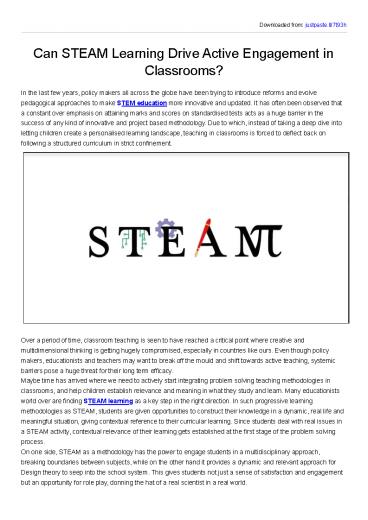Can STEAM Learning Drive Active Engagement in Classrooms? - PowerPoint PPT Presentation
Title:
Can STEAM Learning Drive Active Engagement in Classrooms?
Description:
If we are aiming at huge fundamental shifts from mere memorisation and compartmentalised learning, towards holistic education and deeper learning, then we need to think of dynamic approaches towards learning, and give students more autonomy to shape their learning curve. Clearly, STEAM can be seen as an active driver for capturing a child’s engagement in classrooms and beyond. – PowerPoint PPT presentation
Number of Views:48
Title: Can STEAM Learning Drive Active Engagement in Classrooms?
1
Downloaded from justpaste.it/7t93h
Can STEAM Learning Drive Active Engagement in
Classrooms? In the last few years, policy makers
all across the globe have been trying to
introduce reforms and evolve pedagogical
approaches to make S TEM education more
innovative and updated. It has often been
observed that a constant over emphasis on
attaining marks and scores on standardised tests
acts as a huge barrier in the success of any
kind of innovative and project based methodology.
Due to which, instead of taking a deep dive into
letting children create a personalised learning
landscape, teaching in classrooms is forced to
deflect back on following a structured
curriculum in strict confinement.
Over a period of time, classroom teaching is seen
to have reached a critical point where creative
and multidimensional thinking is getting hugely
compromised, especially in countries like ours.
Even though policy makers, educationists and
teachers may want to break off the mould and
shift towards active teaching, systemic barriers
pose a huge threat for their long term
efficacy. Maybe time has arrived where we need to
actively start integrating problem solving
teaching methodologies in classrooms, and help
children establish relevance and meaning in what
they study and learn. Many educationists world
over are finding S TEAM learning as a key step in
the right direction. In such progressive learning
methodologies as STEAM, students are given
opportunities to construct their knowledge in a
dynamic, real life and meaningful situation,
giving contextual reference to their curricular
learning. Since students deal with real issues in
a STEAM activity, contextual relevance of their
learning gets established at the first stage of
the problem solving process. On one side, STEAM
as a methodology has the power to engage students
in a multidisciplinary approach, breaking
boundaries between subjects, while on the other
hand it provides a dynamic and relevant approach
for Design theory to seep into the school
system. This gives students not just a sense of
satisfaction and engagement but an opportunity
for role play, donning the hat of a real
scientist in a real world.
2
When we deeply study a STEAM module in action, it
has the power to allow learning at a much deeper
level in a childs cognition. Skills for
competent problem solving, coding and decoding
problems at several layers gets integrated,
unintentionally. Educators have observed how such
approaches have helped organic emergence of
Higher Order Thinking skills without any forced
intervention. Knowledge acquisition happens with
application in action. If we are aiming at huge
fundamental shifts from mere memorisation and
compartmentalised learning, towards h olistic
education and deeper learning, then we need to
think of dynamic approaches towards learning, and
give students more autonomy to shape their
learning curve. Clearly, STEAM can be seen as an
active driver for capturing a childs engagement
in classrooms and beyond. Original Source C an
STEAM Learning Drive Active Engagement in
Classrooms?































